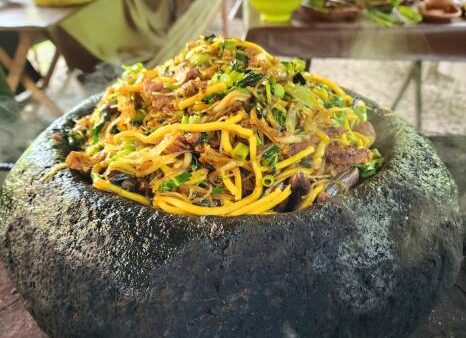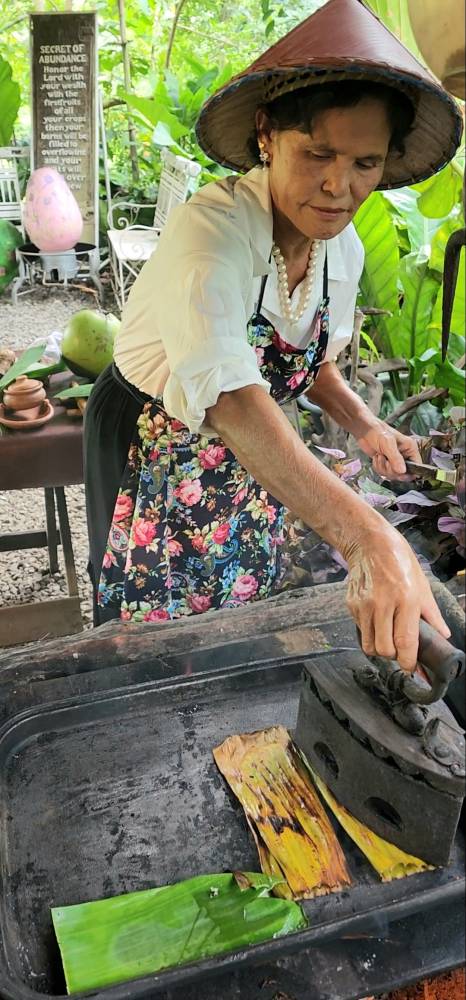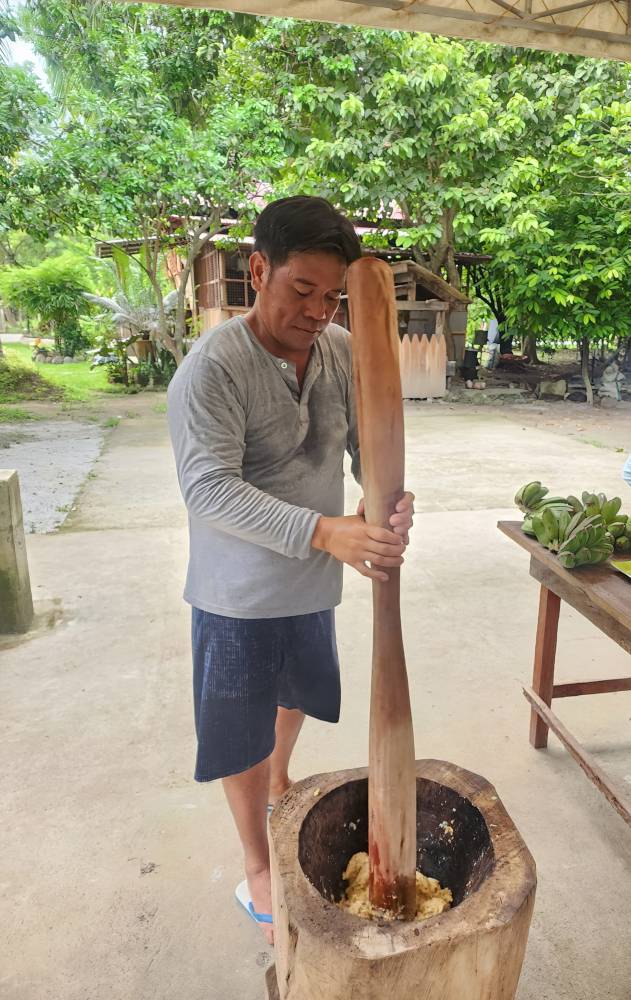Food traditions as social affairs

In the southern Tagalog region there are food rituals that are considered social affairs.
Prepared during “punsyunan,” a word coined from the English word “functions,” delicacies such as nilupak and kalamay are communal affairs—made to welcome guests or to celebrate town fiestas, weddings, and even courtship.
I experienced this at Beegood Agriventures in Tiaong, Quezon, where I was greeted by friendly faces and a large lusong and halo (wooden mortar and pestle). The lusong and halo are the implements used for paglulupak, pagyuyubak, or pagmiminukmok… all of which are local terms that translate to pagbabayo or the pounding of bananas or cassava to make the local delicacy called Nilupak or Minukmok.
I learned from Calabarzon food advocate Tina Decal that paglulupak is the culture of the people from the barrio. In the early years, when coconut plantations were plenty, the “taga-linang” (bukid folk) gathered to interact while making nilupak.
As I watched the lady peel the cooked bananas, and the gentleman pound them to a smooth paste, I noticed how synchronized they were. Sugar, condensed milk, and peanut butter were added precisely when the bananas were at the perfect consistency.

In the olden days, grated coconut and freshly roasted peanuts were used. As such, classic nilupak was by far more aromatic due to the nuts; textured from the coconut bits; richer and tastier from the coconut cream extracted from the pounding of the grated coconut.
Nilupak can be made from saba bananas or cassava. Nilupak na saging must be consumed immediately, as it dries out quickly. Nilupak na cassava lasts longer. On special occasions, the nilupak is shaped to resemble flowers with the use of utensils.
The secret to keeping it soft for a longer period of time is the Star margarine slathered all over it.
To eat the nilupak, a banana leaf is used to pinch off a portion.
Each bite of nilupak is delicious because it is steeped in tradition!
As I drove deeper into the countryside, I couldn’t help but reimagine how the nilupak rituals must have been in the olden days. Before I could paint a whole picture of beautiful women in baro’t saya, I found myself at Ylaya Sta. Elena, San Pablo City, Laguna.
To my surprise, kusineras from the bushes emerged swaying to the tune of Philippine folk songs with gusto.

The dancing ladies led me to the owner of the forest haven, the man known as Kusinero de Bukid Joel Frago and his wife Myrna.
Joel, a former OFW, honed his cooking skills overseas, primarily because he missed food from home. As he settled back to his hometown, he continued to cook and invent dishes to bring delight to his family and their guests.
However, it is Myrna that Joel really cooks for. “I am happy to see my wife happy. I like to cook for her. I make sure she eats well.” The Kalabuko is “Pancit para sa lab ko,” he quipped. It was a recipe Joel developed for his beloved.
The pancit and its ingredients tell the story of their simple life.
What goes into the Kalabuko are primarily kalabasa from their vegetable patch and buko that’s plentiful in their farm. Freshly plucked green papaya is part of the mix. The squash, coconut meat unripe papaya are all grated into long strips, to look like pancit.
The Pancit Kalabuko is ever changing, ever evolving. It is cooked with fresh catch from the seven rivers of San Pablo or freshly hauled seafood from the local market. Seasonal ingredients give it its unique flavor. The rainy season lends wild mushrooms that grow abundantly under the canopy of edible fruit trees. There was sliced longganisa, too. Other vegetables at their prime were likewise added to the pot. The foraged leaves are tossed in last.
All of the above and a splash of coconut aminos (a savory sauce), give the Pancit ni Lab, its lovely flavor.
The gentle breeze, the chirping birds, and the roaming farm animals made cooking the Pancit Kalabuko unforgettable. At the kusinero de bukid’s rustic, make-shift kitchen, a pot carved out of live river rock was being fired. A few minutes later, the fresh catch was sautéed in coconut oil. The other ingredients followed. And just like that, the pancit was ready to serve.
Another dish created by Frago is called Plantsado Lamang Lupa (ironed root crops). It was born out of Joel’s longing for his lola. He recreated this family merienda favorite from memory.
As a young boy, Joel recalled eating this after siesta. He recounted how his grandmother would dig for native gabi. He watched as she peeled and grated it. Lola then combined the root crop with brown sugar and coconut meat. She then spooned a little of the mixture on a banana leaf brushed generously with margarine. After, it is folded neatly.
To cook, the leaves were ironed—yes, literally—with an antique charcoal-fired plancha, eight to 10 minutes per side.
The familia Frago specialty was ready when the mixture became aromatic and when opened, tinged golden brown.
It could be had soft with a light golden crust or toasted and crunchy—as some of Joel’s relatives liked it. The iron is left longer to achieve this. Both ways are delicious.
The day I spent in Quezon, I will always remember for my renewed perspective of the nilupak. What was before my visit, just pounded banana or cassava, is now so much more than that. It is a way of life—a delicacy so special that communities came together to make it with joy and laughter.
San Pablo I will hold also dear, for the endless folk songs; the incredible tales of Joel that made me yearn for the flavors of my youth; the dancers who proved that it is more fun in the Philippines; and Kalabuko, the pancit conceived and cooked with love.

















